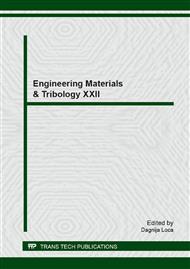p.277
p.285
p.289
p.293
p.297
p.301
p.305
p.309
p.313
Investigation of Hydration Features of the Special Concrete with Aggregates of Various Metal Particles
Abstract:
This study presents an analysis of various size metal particle waste (MP) influences on Portland cement (PC) paste hydration course, concrete sample structure densification during hardening and physical-mechanical properties. Investigations have shown that MP filler accelerates maximum heat release rate in PC pastes. MP intensifies structure development in the early phase, but slows it down in later PC hydration period. After 28-days of hardening the compressive strength of the concrete samples without MP filler is about 20% higher than of samples with MP. When in concrete composition microsilica and MP fillers are used together, compressive strength of concrete sample composition is up to 50% higher than of samples with MP filler only.
Info:
Periodical:
Pages:
297-300
Citation:
Online since:
March 2014
Keywords:
Price:
Сopyright:
© 2014 Trans Tech Publications Ltd. All Rights Reserved
Share:
Citation:


